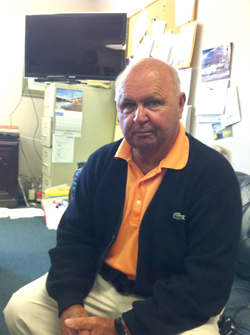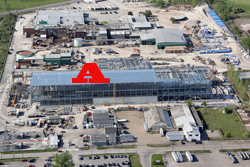Letter leaked: Trades Council To Norampac:
By Frank Parlato
 |
| Palladino, subject of letter to Norampac executives, is unapologetic. |
 |
| Henry Sloma, head of the IDA |
.jpg) |
| On May 10, 1940, Germany launched a full-front invasion of France. By June 22, 1940, France surrendered. But for the United States, Palladino says, the French would be speaking German today. |
 |
| Norampac got $140 million in state and local tax incentives to build their $450 million project. The construction of the 250,000 square foot building (A) was estimated to be about $180 million in construction cost. The bulk of the rest of the cost was to be in equipment for the planned container board plant. The construction work is largely completed and despite large local subsidies, most of the work was performed by out of town workers and contractors. |
The Niagara County Building & Construction Trades Council dashed off a letter to Norampac executives, apologizing for remarks made by Local 91 Business Manager Dick Palladino that appeared in this publication. The letter was leaked to The Reporter despite the fact it was meant as a private missive from the business managers of the Trades Council to Norampac officials.
In the July 17 edition of this paper, Palladino chastised the French Canadian Norampac owners, implying their yellow streaks were larger than the noonday sun. Palladino minced no words in calling the French cowards in WW I and WW II.
An angry Palladino also charged Norampac of shortchanging locals by not hiring them at the $450 million container board plant they are building in Niagara Falls. With $140 million in state and local assistance, much of the job was done utilizing out-of-state workers.
The letter to Norampac, signed by six union leaders, reads as follows:
“Dear Sirs,
“Recently, several articles have appeared in a local tabloid publication called the Niagara Falls Reporter in which Richard Palladino, business manager of Laborers' Local 91, was quoted casting some very disparaging remarks about the owners and the developers of the Greenpac (Norampac) paper mill project. Please be advised that this one person’s comments and opinions are his alone, and do not reflect the opinions of the other sixteen member trades of the Niagara County Building and Construction Trades Council.
“The council wishes to continue pursuing a constructive and productive relationship at the Greenpac site as construction progresses.
“Very Truly,
“Niagara County Trades Business Managers.”
The above letter, dated July 26, 2012, was signed by Robert F. Hess, Heat and Frost Insulators local 4; Daniel J. DeCarlo, Boilermakers Local Union 7; Todd Flynn, Bricklayers and Allied Craftworkers, Local 83; Anthony LoCurto, Cement Masons Local Union 111; and Russell Quarantello, Electrical Workers Local Union 237.
When contacted by The Reporter, Palladino called the letter, “the worst kind of pandering."
"I don’t know how you can go to sleep at night after writing such a letter,” he said. “I’m sorry for their membership.”
Palladino's beef with Norampac is centered around their promise to hire local workers. He said more than 50% of the job has been done by out-of-state workers and less than 20% by local union workers.
Palladino laid emphasis on the last sentence in the letter, which suggests the Trades Council and Norampac have a “constructive and productive relationship.”
“Are they kidding? The work is 80% done,” he said. “What has their ‘productive and constructive relationship’ got them so far?”
Clyde Johnson, Chairman of the Niagara County Building Trades defended the letter.
"The Building Trades Group didn’t agree with (Palladino’s) comments, so we sent a letter to Norampac indicating we are not in agreement with his statements made in the Reporter."
Palladino, who served in the US Navy during Vietnam as qualified submarine sailor, Navy diver and demolition expert, said in the July 17th article that, “We bailed the French out three times – WWI, WWII, and Vietnam."
Referring to the fact that Norampac is owned by French-Canadians, Palladino added, “For them to come over here with workers they picked up in the third world somewhere is inexcusable. They ought to be hiring local, American workers.”
Later in the July article, he said, “you know how to get a Frenchman’s attention? Start talking in German.”
One comment Palladino made was pointed: “Norampac... cut a deal with our tax money, and then used out-of-state workers while our workers stay home. It is not words, but deeds, that make a man politically correct, that’s real political correctness.”
Johnson, a Vietnam Veteran who served in the U. S. Army as a sergeant between 1966-68 earning a combat infantry badge, agreed that Norampac didn’t provide the local hires the unions had hoped for.
"The Trades have been trying to work with them and not everything has gone the way everybody would like it to go,” Johnson said. “There are a lot of things that should have been done differently … But we don’t agree with what Palladino said in the paper… bashing the French and going back talking about previous wars.”
When asked, if there was a “productive and constructive” relationship with Norampac, Johnson said, “The business reps are contacting Norampac all the time trying to get work. Some of it successful, some not.”
Johnson acknowledged Norampac was not legally required to hire locals, or union workers, despite the fact that Norampac received $140,260,500 in tax incentives. Niagara County alone contributed $72,060,000 in sales and property tax credits. Norampac's 250,000-square-foot facility will, when completed, employ 108, which comes to more than one million dollars in incentives for each employee.
Johnson said, “What the state does for local hiring with the incentive package should have been taken care of beforehand. It’s a little after the fact now… It’s hard to get in there and you can’t go in there outside the scope of work, but the (unions) are getting some work. (New York State) has to stop giving tax incentives where they do not require local hiring.”
Russell Quarantello, one of the signatories of the letter, was present during the interview with Palladino when he made disparaging comments about the owners of Norampac.
“I remember when he said it. And I cringed,” said Quarantello, “Yet I give him credit for saying it. But to be honest, I don’t think antagonizing is going to help.”
When asked if the letter's indication of a “productive and constructive” relationship with Norampac is a fair characterization, Quarantello said, “It’s a big project that has gone bad. . . We have gotten some of the small jobs. And as bad as it sounds, I would rather have the small jobs, than no jobs at all. If our union didn’t get any of that work, it would be way worse.”
Quarantello estimated that $16 million of a total $19 million of electrical work has gone to non-union and out-of-state workers.
“The people who made the deal to give them the incentives did not enforce a local hire, and that is the real shame,” Quarantello said.
More than half of the tax incentives granted to Norampac came from the Niagara County IDA. Chairman Henry “Mickey” Sloma was asked if it would have been better to have stronger language in about local hires.
Sloma, who met repeatedly with Norampac executives to make the deal, said, “From the IDA perspective, it is our job to remove barriers so that people invest in Niagara County. We tell them what our intentions are, and we hope they can work it out with the local labor people… I’m not sure what else we could have done.”
What about stronger language? In order to get tax benefits, require, for instance, 75% local hires?
Sloma said, “Norampac was going to build this plant in Montreal. We convinced them to build it in Niagara County. You assume they are going to use a sufficient amount of local labor and services, especially on a project of that size. They indicated they would in conversations.
“But our job is not to put up barriers. Our job is to take barriers down ... We want people to invest here. If Norampac had decided to put the plant in Montreal because we were inhospitable, local workers would have gotten zero percent of the jobs."
Pointing out that the taxes Norampac will be paying over the next 20 years will be in the tens of millions, and the jobs they will provide, that would have otherwise gone to Montreal, are real jobs, Sloma said, “I think we did our job, and they are in fact building it here. If we had been tougher and they had gone to Montreal, what would (the union leaders) have said about the IDA? I think we did a reasonable balance to get a half billion dollar investment in Niagara County.”
Sloma added that companies are not beating down the door to come to Niagara and pointed out that, in the past, it was unions themselves, and their reputation, that deterred a lot of business from locating here.
“I know that other communities across the state, and across the county, deal with requiring local hires in return for tax incentives,” Sloma said, “Monroe County has some stronger language... If people are fighting to get into Niagara County, you can have all kinds of quotas (but) we are trying to attract them and to get them to invest. (But) in Niagara County, local hiring quotas, I don’t think it works.”
Palladino disagrees.
“I feel stronger about it now than I did then,” he said. “If I had stronger words than what you quoted in your newspaper, I’d use them. There should have been language in the contract. Local taxpayers helped subsidize this project; local workers should have built it.”
(A call to Norampac General Manager Luc Nadeau was not returned.)